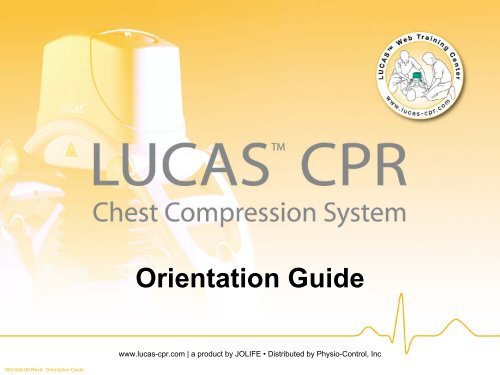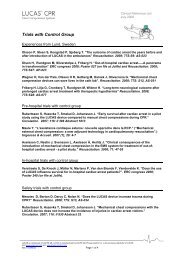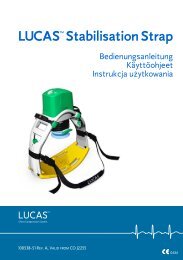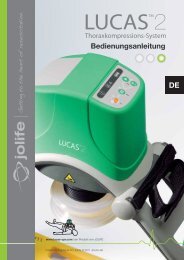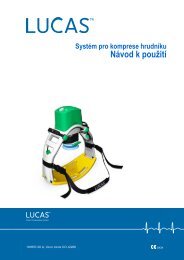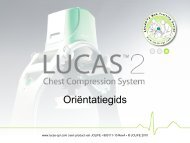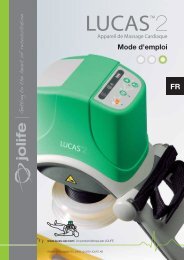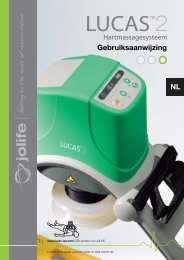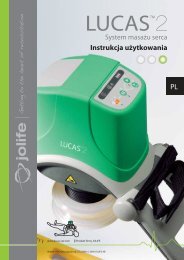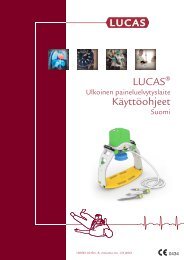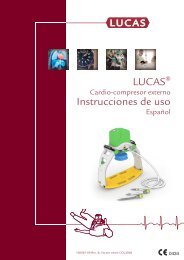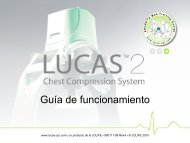download presentation in pdf format - Lucas CPR
download presentation in pdf format - Lucas CPR
download presentation in pdf format - Lucas CPR
Create successful ePaper yourself
Turn your PDF publications into a flip-book with our unique Google optimized e-Paper software.
Objectives• Expla<strong>in</strong> the emphasis on effective <strong>CPR</strong>• Understand the importance of Coronary PerfusionPressure (CPP)• Def<strong>in</strong>e the characteristics of effective <strong>CPR</strong>accord<strong>in</strong>g to Guidel<strong>in</strong>es• Describe the effects of rescuer fatigue on chestcompressions900 048-00 RevA Orientation Guide4
ObjectivesReview the use of LUCAS <strong>in</strong>clud<strong>in</strong>g:• Unpack<strong>in</strong>g and connect<strong>in</strong>gthe air source• Assembly• Adjustment• Operation• Stabilization strap• Defibrillation• Ventilation• Transport<strong>in</strong>g the patient• Chang<strong>in</strong>g air source• Remov<strong>in</strong>g from patient900 048-00 RevA Orientation Guide5
Sudden Cardiac Arrest (SCA)Treatment Options• <strong>CPR</strong>• Defibrillation• Oxygenation with ventilation900 048-00 RevA Orientation Guide6
<strong>CPR</strong> Guidel<strong>in</strong>es have been changed tomake <strong>CPR</strong> more effectiveWhy is <strong>CPR</strong> so important?900 048-00 RevA Orientation Guide7
Coronary Perfusion Pressure (CPP)• Measure of pressure driv<strong>in</strong>g blood flow to theheart muscle• Typically 60 mmHg• CPP drops dramatically <strong>in</strong> cardiac arrest900 048-00 RevA Orientation Guide8
<strong>CPR</strong>• Provides blood and oxygen tothe bra<strong>in</strong> and heart• Generates CPP• CPP ≥ 15 mmHg associatedwith return of spontaneouscirculation (ROSC)Paradis NA, Gerard B, Rivers EP. et al. Coronary perfusion pressure and the return of spontaneous circulation <strong>in</strong> humancardiopulmonary resuscitation. JAMA. 1990;263:1106-1113.900 048-00 RevA Orientation Guide9
Three Phases of Cardiac ArrestElectrical:• 0-3 m<strong>in</strong>utes• Immediate defibrillationMetabolic:• > 10 m<strong>in</strong>utes• ROSC highly unlikelyCirculatory:• 4-10 m<strong>in</strong>utes• <strong>CPR</strong>: Ability to generateadequate CPP l<strong>in</strong>ked to ROSCWeisfeldt ML, Becker LB. Resuscitation After Cardiac Arrest. A 3-phase time-sensitive model. JAMA. 2002;288(23):3035-3038.900 048-00 RevA Orientation Guide10
Rescuer Fatigue• May lead to <strong>in</strong>adequatecompression rates and depths• Significant fatigue and shallowcompressions are seen after 1m<strong>in</strong>ute of <strong>CPR</strong> 1• Rescuers may deny that fatigueis present for ≥ 5 m<strong>in</strong>utes 21 Ochoa FJ, Ramalle-Gómara E, Lisa V, Saralegui I. The effect of rescuer fatigue on the quality of chest compressions.Resuscitation. 1998;37:149-52.2 Hightower D, Thomas S, Stone C, Dunn K, March J. Decay <strong>in</strong> quality of closed-chest compressions over time. Annals ofEmergency Medic<strong>in</strong>e. 1995;26:300-303.900 048-00 RevA Orientation Guide11
<strong>CPR</strong> Recommendations• Ratio: 30 compressions to 2 ventilations• Rate: 100 compressions/m<strong>in</strong>ute m<strong>in</strong>imum• Depth: 1 ½ -2 <strong>in</strong>ches (4-5 cm)• Duty cycle: 50%• Allow chest wall to recoil completely• M<strong>in</strong>imize <strong>in</strong>terruptions2005 American Heart Association Guidel<strong>in</strong>es for Cardiopulmonary Resuscitation and Emergency Cardiovascular Care. Circulation2005;112(suppl IV):IV-25900 048-00 RevA Orientation Guide12
Guid<strong>in</strong>g Pr<strong>in</strong>ciple• The Guidel<strong>in</strong>es and several studies have stressed the importanceof m<strong>in</strong>imiz<strong>in</strong>g <strong>in</strong>terruptions <strong>in</strong> chest compressions• Guidel<strong>in</strong>es recommend switch<strong>in</strong>g rescuers perform<strong>in</strong>gcompressions every 2 m<strong>in</strong>utes• One study demonstrated it took about 90 seconds after a pause<strong>in</strong> compressions to re-establish previous CPP levels• Mechanical chest compressors elim<strong>in</strong>ate unnecessary<strong>in</strong>terruptions to compressionsSteen S, Liao Q, Pierre L, Paskevicius A, Sjöberg T. The critical importance of m<strong>in</strong>imal delay between chest compressions andsubsequent defibrillation: a haemodynamic explanation. Resuscitation. 2003;58:249-258.900 048-00 RevA Orientation Guide13
Bottom L<strong>in</strong>e• Heart and bra<strong>in</strong> perfusion is critical• The Guidel<strong>in</strong>es changed to make <strong>CPR</strong>more effective• Most rescuers have difficulty meet<strong>in</strong>gand ma<strong>in</strong>ta<strong>in</strong><strong>in</strong>g <strong>CPR</strong> accord<strong>in</strong>g tothe Guidel<strong>in</strong>es• Look<strong>in</strong>g for new solutions to improve <strong>CPR</strong>900 048-00 RevA Orientation Guide14
LUCAS• LUCAS is a portable device used toprovide external cardiac compressions• LUCAS meets all of the recommendedGuidel<strong>in</strong>es for effective <strong>CPR</strong> and won’tget tired!• LUCAS can be used dur<strong>in</strong>g transport• LUCAS is easy to use and a great assetto the team900 048-00 RevA Orientation Guide15
LUCAS Chest Compression System900 048-00 RevA Orientation Guide16
Uses• Adult patients <strong>in</strong> acute circulatory arrest• loss of consciousness• absence of spontaneous breath<strong>in</strong>g and pulse• LUCAS should only be use <strong>in</strong> cases wheremanual chest compression would be used• Intended only for temporary use900 048-00 RevA Orientation Guide17
Contra<strong>in</strong>dications• Too small adult patient• Too large patient• Children• Traumatic <strong>in</strong>jury• Advanced pregnancy900 048-00 RevA Orientation Guide18
LUCAS Cardiac Compression SystemKnob positions:• ADJUST (1)• LOCK (2)• ACTIVE (3)900 048-00 RevA Orientation Guide19
Basic Steps for Use• Arrive at patient and checkresponsiveness• Unpack LUCAS andconnect the air• Assembly• Adjustment• Operation• Stabilization strap• Defibrillation• Ventilation• Transport<strong>in</strong>g the patient• Chang<strong>in</strong>g air source• Remov<strong>in</strong>g from patient900 048-00 RevA Orientation Guide20
Arrival at the patient• Confirm cardiac arrest• Beg<strong>in</strong> manual <strong>CPR</strong> untilLUCAS is ready900 048-00 RevA Orientation Guide21
Unpack<strong>in</strong>g LUCAS• Place bag on ground with the top ofLUCAS closest to you• Open cover so that entire bag unfolds900 048-00 RevA Orientation Guide22
Connect<strong>in</strong>g the Air• Confirm knob is <strong>in</strong> the ADJUST position• Attach air hose connector to regulator ofair cyl<strong>in</strong>der or to wall outlet• Open air valve, if us<strong>in</strong>g a pressureregulator• Always follow proper sequence of airconnection and assembly so the devicedoesn’t start compress<strong>in</strong>g by mistakeand potentially cause <strong>in</strong>jury900 048-00 RevA Orientation Guide23
Assembly• Remove back plate from bag• Stop manual <strong>CPR</strong>• Lift up patient’s upper body• Lay back plate under bodybelow armpits• Resume manual <strong>CPR</strong>900 048-00 RevA Orientation Guide24
Assembly• Lift upper part out of bag• Open support legs• Pull release r<strong>in</strong>gs to ensure clawlocks are opened900 048-00 RevA Orientation Guide25
Assembly• Stop manual compressions• Place upper part over patient’s chestso claw locks engage with back plate• Lock support legs to back plate• Pull up to ensure legs are locked toback plate900 048-00 RevA Orientation Guide26
Adjustment-PositionFor effective compressions and to avoidserious patient <strong>in</strong>jury it's important tomake sure to start with the suction cup<strong>in</strong> the correct position:• Lower edge of suction cupshould be immediately abovethe end of the sternum• Suction cup should be centeredover the sternum900 048-00 RevA Orientation Guide27
Adjustment Procedure• If the suction cup is too low on thesternum, reposition LUCAS bypull<strong>in</strong>g it up higher on the chest• Compress <strong>in</strong> the right spot to avoidserious patient <strong>in</strong>jury and geteffective compressions900 048-00 RevA Orientation Guide28
Adjustment Procedure• Ensure the knob is <strong>in</strong> theADJUST position• Lower suction cup until pressurepad <strong>in</strong>side suction cup touchespatient’s chest900 048-00 RevA Orientation Guide29
Adjustment Procedure• Do not use LUCAS if:• pressure pad doesn’t touch chest• upper part won’t fit around patient orclaw locks won’t fasten to back plate• Cont<strong>in</strong>ue with manual compressions900 048-00 RevA Orientation Guide30
Adjustment Procedure• Critical to make necessary adjustments rapidly to m<strong>in</strong>imize “noflow” time or time without compressions• After the back plate is placed under the patient, it should take lessthan 20 seconds to stop manual compressions, connect the upperpart of LUCAS, and start mechanical compressions• “Practice makes perfect”900 048-00 RevA Orientation Guide31
Operation• Turn knob to ACTIVE to beg<strong>in</strong>compressions• Check for proper position• Turn knob to ADJUST toreposition, if needed, and back toACTIVE to resume compressions• Turn knob to LOCK to stopcompressions for any reasons• Do not leave patient or deviceunattended while LUCAS is active900 048-00 RevA Orientation Guide32
Stabilization Strap• Start compressions• Place support cushion under patient’s neck• Fasten cushion straps to device straps• Tighten the straps• Delay, or don’t use stabilization strapwhen it might impair treatment900 048-00 RevA Orientation Guide33
Defibrillation• Defibrillation pads may be appliedbefore or after LUCAS is placed• Make sure pads or wires are notunder suction cup900 048-00 RevA Orientation Guide34
Defibrillation• Stop LUCAS dur<strong>in</strong>g ECG rhythmcheck or analysis – compressionscan <strong>in</strong>terfere with ECG analysis• Perform defibrillation as usualaccord<strong>in</strong>g to the manufacturer’s<strong>in</strong>structions follow<strong>in</strong>g AED promptsand agency protocols• Check for correct position of LUCASon patient’s chest after defibrillationshock and adjust if needed900 048-00 RevA Orientation Guide35
Ventilation• Unprotected airway• stop LUCAS while deliver<strong>in</strong>gbreaths accord<strong>in</strong>g to the Guidel<strong>in</strong>es• Protected airway• deliver breaths <strong>in</strong>dependently ofLUCAS operation accord<strong>in</strong>g tothe Guidel<strong>in</strong>es900 048-00 RevA Orientation Guide36
Transport<strong>in</strong>g the Patient• Secure the patient’s arms• Apply straps on LUCAS topatient arms• Do not over-tighten• Do not lift LUCAS by thearm straps900 048-00 RevA Orientation Guide37
Transport<strong>in</strong>g the Patient• Lift<strong>in</strong>g the patient• One person on each sideand one person support<strong>in</strong>gthe patient’s head, even withstabilization strap <strong>in</strong> place• Those at patient’s side lift withone hand beneath claw locks ofback plate keep<strong>in</strong>g f<strong>in</strong>gers clearof claw locks• Other hand lifts patient’s leg900 048-00 RevA Orientation Guide38
Transport<strong>in</strong>g the Patient• Turn knob to LOCK to pausecompressions dur<strong>in</strong>g lift• Check position of suction cup• Turn knob to ACTIVE toresume compressions900 048-00 RevA Orientation Guide39
Transport<strong>in</strong>g the PatientOnce the patient is placed onthe stretcher or other surface,LUCAS may be <strong>in</strong> active statedur<strong>in</strong>g all horizontal lifts andmovements900 048-00 RevA Orientation Guide40
Chang<strong>in</strong>g Air Source Dur<strong>in</strong>g Use• Set knob to ADJUST• Close valve on used air cyl<strong>in</strong>der• Disconnect air hose from air source• Attach air hose to new air source• Open valve on new air cyl<strong>in</strong>der• Adjust the height of suction cup, if needed• Turn knob to LOCK• Turn knob to ACTIVE to cont<strong>in</strong>uecompressions900 048-00 RevA Orientation Guide41
Remov<strong>in</strong>g LUCAS from Patient• Turn knob to ADJUST• Raise suction cup to uppermost position• Close air valve and disconnect air hose from air source• Remove patient arms from support straps• Disconnect and remove stabilization strap• Disconnect upper part of LUCAS from back plate• Remove back plate900 048-00 RevA Orientation Guide42
Side Effects• Bruis<strong>in</strong>g and soreness of the chest is common dur<strong>in</strong>guse of LUCAS• The International Liaison Committee on Resuscitation(ILCOR) states the follow<strong>in</strong>g side effects of <strong>CPR</strong>:• Rib fractures and other <strong>in</strong>juries are common but acceptableconsequences of <strong>CPR</strong> given the alternative of death fromcardiac arrest• After the resuscitation, all patients should be reassessed andreevaluated for resuscitation-related <strong>in</strong>juries2005 International Consensus on Cardiopulmonary Resuscitation (<strong>CPR</strong>) and Emergency Cardiovascular Care (ECC) Science withTreatment Recommendations. Circulation. 2005;112(suppl III):III-11.900 048-00 RevA Orientation Guide43
Summary• <strong>CPR</strong> is receiv<strong>in</strong>g renewed attention• More emphasis on meet<strong>in</strong>g Guidel<strong>in</strong>e recommendations for <strong>CPR</strong>• LUCAS achieves effective and consistent compressions easily• LUCAS helps m<strong>in</strong>imize unnecessary <strong>in</strong>terruptions to compressions• Practic<strong>in</strong>g LUCAS application will be benefit both rescuer and patient900 048-00 RevA Orientation Guide44
900 048-00 RevA Orientation Guide45


